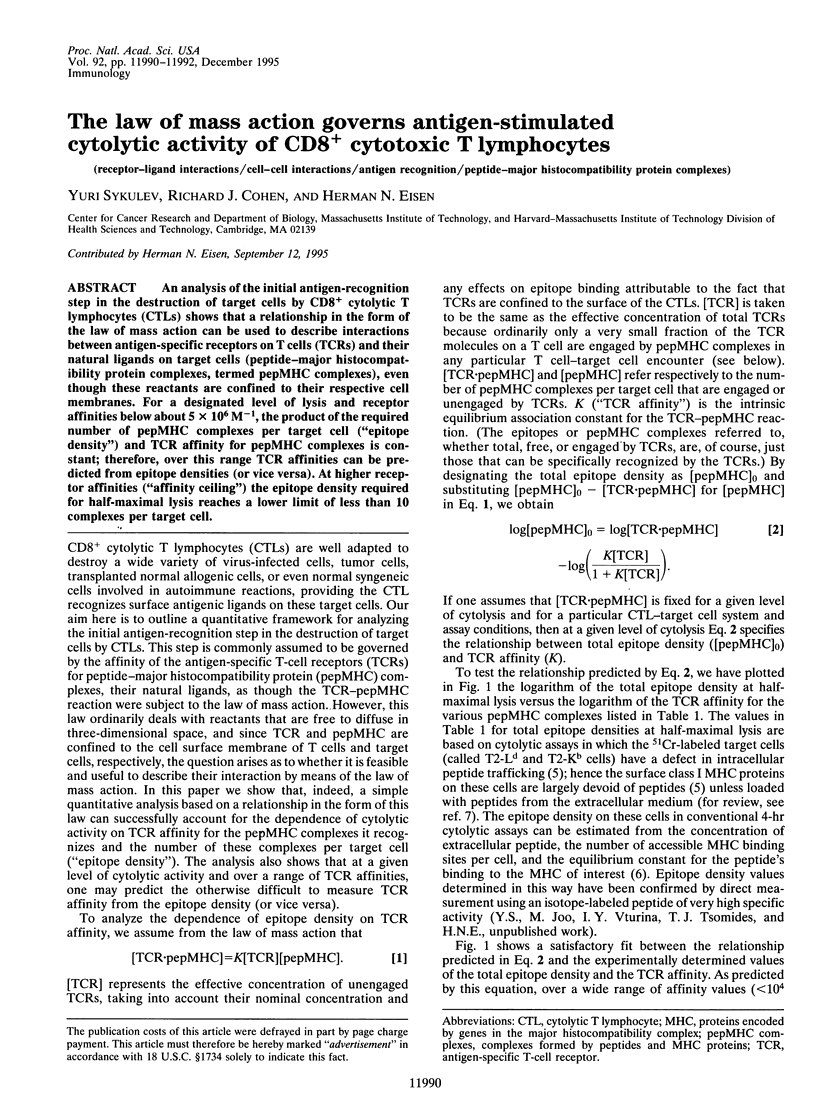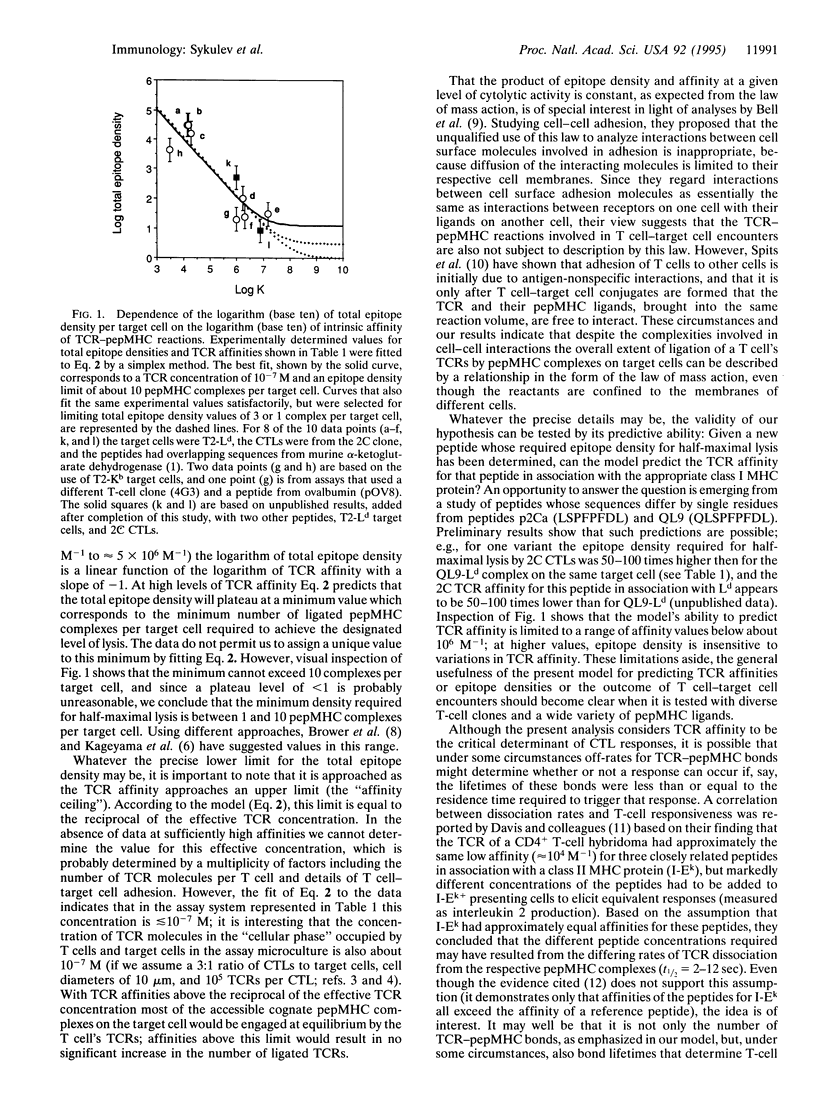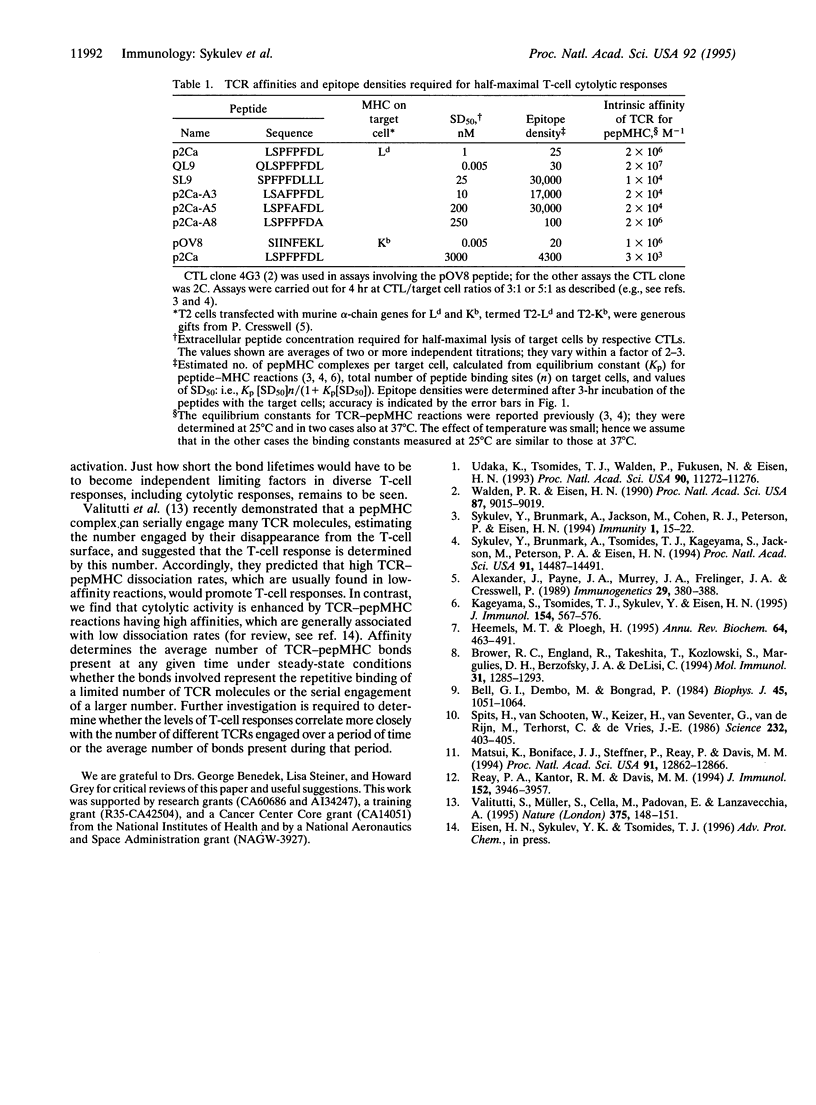Abstract
An analysis of the initial antigen-recognition step in the destruction of target cells by CD8+ cytolytic T lymphocytes (CTLs) shows that a relationship in the form of the law of mass action can be used to describe interactions between antigen-specific receptors on T cells (TCRs) and their natural ligands on target cells (peptide-major histocompatibility protein complexes, termed pepMHC complexes), even though these reactants are confined to their respective cell membranes. For a designated level of lysis and receptor affinities below about 5 X 10(6) M-1, the product of the required number of pepMHC complexes per target cell ("epitope density") and TCR affinity for pepMHC complexes is constant; therefore, over this range TCR affinities can be predicted from epitope densities (or vice versa). At higher receptor affinities ("affinity ceiling") the epitope density required for half-maximal lysis reaches a lower limit of less than 10 complexes per target cell.
Full text
PDF


Selected References
These references are in PubMed. This may not be the complete list of references from this article.
- Alexander J., Payne J. A., Murray R., Frelinger J. A., Cresswell P. Differential transport requirements of HLA and H-2 class I glycoproteins. Immunogenetics. 1989;29(6):380–388. doi: 10.1007/BF00375866. [DOI] [PubMed] [Google Scholar]
- Bell G. I., Dembo M., Bongrand P. Cell adhesion. Competition between nonspecific repulsion and specific bonding. Biophys J. 1984 Jun;45(6):1051–1064. doi: 10.1016/S0006-3495(84)84252-6. [DOI] [PMC free article] [PubMed] [Google Scholar]
- Brower R. C., England R., Takeshita T., Kozlowski S., Margulies D. H., Berzofsky J. A., Delisi C. Minimal requirements for peptide mediated activation of CD8+ CTL. Mol Immunol. 1994 Nov;31(16):1285–1293. doi: 10.1016/0161-5890(94)90079-5. [DOI] [PubMed] [Google Scholar]
- Heemels M. T., Ploegh H. Generation, translocation, and presentation of MHC class I-restricted peptides. Annu Rev Biochem. 1995;64:463–491. doi: 10.1146/annurev.bi.64.070195.002335. [DOI] [PubMed] [Google Scholar]
- Kageyama S., Tsomides T. J., Sykulev Y., Eisen H. N. Variations in the number of peptide-MHC class I complexes required to activate cytotoxic T cell responses. J Immunol. 1995 Jan 15;154(2):567–576. [PubMed] [Google Scholar]
- Matsui K., Boniface J. J., Steffner P., Reay P. A., Davis M. M. Kinetics of T-cell receptor binding to peptide/I-Ek complexes: correlation of the dissociation rate with T-cell responsiveness. Proc Natl Acad Sci U S A. 1994 Dec 20;91(26):12862–12866. doi: 10.1073/pnas.91.26.12862. [DOI] [PMC free article] [PubMed] [Google Scholar]
- Reay P. A., Kantor R. M., Davis M. M. Use of global amino acid replacements to define the requirements for MHC binding and T cell recognition of moth cytochrome c (93-103). J Immunol. 1994 Apr 15;152(8):3946–3957. [PubMed] [Google Scholar]
- Spits H., van Schooten W., Keizer H., van Seventer G., van de Rijn M., Terhorst C., de Vries J. E. Alloantigen recognition is preceded by nonspecific adhesion of cytotoxic T cells and target cells. Science. 1986 Apr 18;232(4748):403–405. doi: 10.1126/science.3485822. [DOI] [PubMed] [Google Scholar]
- Sykulev Y., Brunmark A., Jackson M., Cohen R. J., Peterson P. A., Eisen H. N. Kinetics and affinity of reactions between an antigen-specific T cell receptor and peptide-MHC complexes. Immunity. 1994 Apr;1(1):15–22. doi: 10.1016/1074-7613(94)90005-1. [DOI] [PubMed] [Google Scholar]
- Udaka K., Tsomides T. J., Walden P., Fukusen N., Eisen H. N. A ubiquitous protein is the source of naturally occurring peptides that are recognized by a CD8+ T-cell clone. Proc Natl Acad Sci U S A. 1993 Dec 1;90(23):11272–11276. doi: 10.1073/pnas.90.23.11272. [DOI] [PMC free article] [PubMed] [Google Scholar]
- Valitutti S., Müller S., Cella M., Padovan E., Lanzavecchia A. Serial triggering of many T-cell receptors by a few peptide-MHC complexes. Nature. 1995 May 11;375(6527):148–151. doi: 10.1038/375148a0. [DOI] [PubMed] [Google Scholar]
- Walden P. R., Eisen H. N. Cognate peptides induce self-destruction of CD8+ cytolytic T lymphocytes. Proc Natl Acad Sci U S A. 1990 Nov;87(22):9015–9019. doi: 10.1073/pnas.87.22.9015. [DOI] [PMC free article] [PubMed] [Google Scholar]


